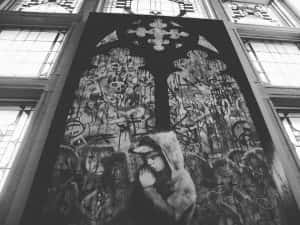[mks_dropcap style=”letter” size=”48″ bg_color=”#ffffff” txt_color=”#000000″]‘I[/mks_dropcap] think a museum is a bad place to look at art.’ This saying was quoted from Banksy’s interview with The Guardian in 2015. However, the Street Art Legend from Bristol City went back on his word recently. The Modern Contemporary Museum Amsterdam, also known as Moco, is holding Banksy’s ‘Laugh Now’ exhibition. For the first time in history, there is a Banksy exhibition in a museum. The exhibition contains around 50 original works, including all his famous works like Laugh Now, Barcode, Girl with Balloon and many more.
Graffiti is an inner conversation within artists themselves as well as communication between artists and passers-by. Banksy is well known for his outdoor art. With the characteristic stencil techniques combined with dark humour, Banksy has created various street artworks on publicly visible surfaces to express his political and social commentary. Not everyone knows that Banksy also makes art for indoors. Original and unique works on canvas, wood and paper with different styles reflect the British artists’ philosophy of sarcasm on capitalism and commodity society.
Most people are impressed by Banksy’s remarkable talent, but some will also question the legality of the graffiti
Banksy has always stood by his principle not to use his own artwork for commercial purposes, but art auctioneers have been known to sell the street art on location and leave the problem of removal in the hands of the winning bidders. Since Banksy created his first artwork, he has been the most controversial artist in the world. Most people are impressed by Banksy’s remarkable talent, but some will also question the legality of the graffiti.

Anti-social criminal?
Graffiti exists as a paradoxical phenomenon, as both aesthetic practice and criminal activity. Street artists often vigorously assert the cultural merit of street art. Detractors will stand for its removal from urban streetscapes to recover the tidy appearance of a city, as well as they would stand for prosecution of the graffiti workers. According to the definition, anyone whose behavior is regarded as ‘different’, or outside the norm, could be labelled as anti-social. However, the subjectivity and context specificity of anti-social behavior -ASB- means some behaviors will be unacceptable in one situation, but accepted, or even worshipped in another context. Banksy’s art work is interesting because he is also trying to show the subjectivity of that definition.
When Banksy’s work appeared on a building owned by the Bristol City Council in 2006, the council saw the graffiti as an act of vandalism to private property. Therefore, they tended to get support from the public to remove it. However, some of the artworks were becoming more accepted as an individual urban ‘art’ form and a brilliant way of self expression in the city. Moreover, people were very confident in the tourist potential of the graffiti. The public argued the difference between Banksy’s works and tag graffiti, and they voted to keep all the works by their local artist. It turned out that rather than calling Banksy an anti-social criminal, we should view him as an anti-social cynic. His graffito demonstrated popular acceptance, and so he became a star in his hometown, and not much later: the United Kingdom’s favorite artist.

Creative Art Genius
Why can Banksy’s art be accepted worldwide? Perhaps Banksy himself has given the right answer: ‘Modern street art is the product of a generation tired of growing up with a relentless barrage of logos and images being thrown at their head every day, and much of it is an attempt to pick up these visual rocks and throw them back.’ As a way of personal expression, the core spirit of graffiti is a challenge to be free. Younger generations are trying to seek various channels to express their ideas. Influenced by subcultural forms, like rock ‘n roll music, the youth has developed distinctive world views for their own. For this reason younger generations find it easy to empathize with Banksy regarding his opinions on political issues and mainstream culture.
Critics commented on the fact that Banksy’s Girl with Balloon-image was voted Britain’s best-loved work of art: ‘The average intellect and feeling of the majority of the public gives them zero competence to distinguish what is really excellent’, were the exact words Jonathan Jones wrote on civil art critics for the Guardian. From his and likeminded people’s perspectives, Banksy’s art can’t be called real art due to its oversimplification of human emotions. They say that Banksy’s works are very direct and easy to get the meaning of.
Art doesn’t necessarily have to be ambiguous and difficult, especially for the generation living in the information age

Nevertheless, this can’t be the reason why his graffiti lacks the spirit of art. Art doesn’t necessarily have to be ambiguous and difficult, especially for the generation living in the information age. We don’t have time to understand the complex philosophy and abstract meaning from the paintings created during the Renaissance period because we must handle massive information flows everyday. Meanwhile, the clarity of the images and their messages serves as a rebellion against the modern society. In that way the street artists precisely cater to our -the younger generation’s- requirements for art.
Originated from simple names on walls and subways, the graffiti has grown into a branch of modern art with unique aesthetics. There will be more and more inspiring works from Banksy and other graffiti artists, while simultaneously arguments on this form of art will always exist. For our generation, the art and its simplicity is a reflection of modern-day society. So we will follow the spirit of this exhibition: Laugh Now, and just enjoy the artworks.
Photography: Cris Ling / Final editor: Iris Ausems





